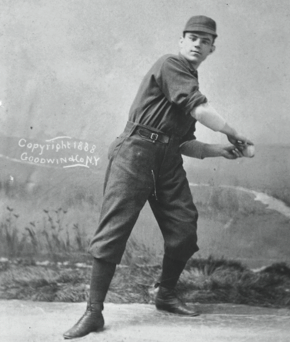October 6, 1886: Days after strikeout record, rookie Matt Kilroy pitches Orioles’ first no-hitter in American Association
 Matt Kilroy was just 19 years old when he made his major-league debut for the American Association’s Baltimore Orioles on April 17, 1886. It wasn’t any ol’ debut, either; the young left-hander was the Orioles’ Opening Day pitcher. There was “already a buzz”1 in the Oriole Park crowd of approximately 6,000 spectators, as Kilroy had won 29 games the year before, pitching for the Augusta Browns in the Southern League. Now in the American Association, Kilroy struck out seven batters and defeated Brooklyn, 4-1, limiting the visiting team to just two hits.2
Matt Kilroy was just 19 years old when he made his major-league debut for the American Association’s Baltimore Orioles on April 17, 1886. It wasn’t any ol’ debut, either; the young left-hander was the Orioles’ Opening Day pitcher. There was “already a buzz”1 in the Oriole Park crowd of approximately 6,000 spectators, as Kilroy had won 29 games the year before, pitching for the Augusta Browns in the Southern League. Now in the American Association, Kilroy struck out seven batters and defeated Brooklyn, 4-1, limiting the visiting team to just two hits.2
According to Kilroy’s SABR biography, the 1969 edition of the Baseball Encyclopedia credited him with three no-hitters in 1886.3 The first was on April 26 against the Philadelphia Athletics. The Cincinnati Enquirer reported that “no base hits were made” off Kilroy, and that he struck out 13 Athletics batters.4 In only his fifth start of the season, he had a perfect game through the first seven innings (“the Athletics went out in one, two, three order”5). As of 2024, however, Kilroy’s April 26 start is officially considered a one-hitter, based on box scores crediting Philadelphia first baseman Harry Stovey with a hit.
The second potential no-no occurred on August 20. Kilroy faced the Athletics once again.6 He and Philadelphia starter Cyclone Miller were locked in a pitchers’ duel for nine innings. Kilroy struck out 10 while Miller fanned nine. The Philadelphia Times reported that “the feature [of the game] was a stop with one hand by [Orioles second baseman Mike Muldoon] of an apparently safe hit.”7 This may have been the basis for the potential no-hitter, but in the box scores each pitcher was charged with allowing one base hit, with Stovey again accounting for the sole Philadelphia safety. Baltimore prevailed, 1-0, on a run scored in the first inning, thanks to Philadelphia errors. Miller had a no-hitter until the ninth inning, when the Orioles’ Jumbo Davis finally got a hit.
Kilroy’s only 1886 no-hitter still recognized in 2024 took place on October 6. The last-place Orioles were visiting Recreation Park in Allegheny City, located across the Allegheny River from downtown Pittsburgh, to play the American Association’s Pittsburgh club, which was also known as the Alleghenys.8 Three days earlier, on October 3, Kilroy had struck out four Louisville batters in a 5-5, seven-inning tie called due to darkness. That gave him 485 strikeouts in the season, passing the major-league mark of 483, set by Hugh Daily in the Union Association in 1884.9
Kilroy, who started 68 of Baltimore’s 139 games in 1886, pitched again on October 5, in the second game of a doubleheader at Recreation Park. Baltimore won the opener 6-3, but Kilroy’s start was called on account of darkness after five innings, with the score tied, 3-3. Kilroy allowed two hits while striking out eight, adding to his record total. Pittsburgh’s starter, Ed Morris, had yielded five hits in five innings.
The next day, Kilroy and Morris faced each other again. Morris was a workhorse for Pittsburgh, thriving after the American Association permitted overhand pitching during the 1885 season. He led the league in innings pitched (581) and strikeouts (298) in ’85. Coming into this game, the 24-year-old lefty had won 38 games for the second-place Alleghenys, and he wound up starting 63 of the team’s 140 games. He also had a major-league-leading 11 shutouts.10
Kilroy was looking for his 29th win of the season. Since September 21, he had made seven starts for the Orioles. In those contests, Baltimore had won twice and lost once; Kilroy had also pitched in four tie games – three had been tied after seven innings and the October 5 knotted game after five frames.
Before a Recreation Park crowd of not even 300 people – the Louisville Courier-Journal reported that “the attendance was the smallest of the year”11 – Kilroy was exceptional. Only four opposing batters reached first base: three on errors and one on a base on balls. The Pittsburgh Post informed its readers that the home team was “utterly unable to do anything” against Kilroy, and that the Allegheny batters were “completely at his mercy throughout the game.”12
The Orioles scored all the runs they needed in the first inning. After Morris retired leadoff batter Manning, Blondie Purcell singled and Joe Sommer reached on shortstop Pop Smith’s two-base error. Jumbo Davis also singled. Morris’s batterymate, Fred Carroll, was charged with “a couple of passed balls,”13 and all of this resulted in Baltimore’s scoring four times.
In the fourth inning, Baltimore added another run. Morris struck out Milt Scott, but Carroll dropped the third strike, and Scott ran to first base. Carroll “secured the ball in time to throw to first,”14 but first baseman Otto Schomberg muffed the throw. Jimmy Macullar was walked by Morris, moving Scott to second. Another passed ball by Carroll moved Scott to third, and he scored on a double by Kilroy. In a wild turn of events, both Macullar and Kilroy were thrown out at the plate on the same play. Morris struck out Tom Dolan to end the Keystone Kops-type inning.
Pittsburgh’s best chance for a base hit took place in the sixth inning. Fred Mann hit a grounder to Baltimore third baseman Davis. The Pittsburgh Post stated that “the ball was clearly fumbled by that player, may be given a hit, but it certainly should not so be scored.”15 All accounts agreed with the Post. In fact, Davis committed three errors in the game.16
In the seventh inning, Dolan singled. Kilroy, who was the only Baltimore player with more than one hit, also singled. A fly ball by Manning and Purcell’s sacrifice brought Dolan home with Baltimore’s sixth and final run of the game.
In the ninth inning, Kilroy struck out Tom Brown, Mann, and Schomberg “in rapid succession and the game ended as ingloriously as it began,” noted the Pittsburgh Post.17 Baltimore’s strikeout king added 11 more K’s to his record sum, and despite four miscues by his team, he did not allow Pittsburgh to score. Only one baserunner reached second,18 and that was due to one of the errors. The Baltimore Sun praised Kilroy by writing that this was “the finest exhibition of ball twirling seen this season.”19
The Orioles had seven hits against Morris, with the only extra-base hit coming from Kilroy.20 One of Baltimore’s hits was due to a fielding blunder by Morris when he misjudged a little pop fly and allowed it “to drop almost at his feet, without touching it.”21 Commenting on the team’s defense, which included two errors and four passed balls, the Pittsburgh Post remarked that “the Alleghenys will never win second place through their own exertions.”22
This was the first no-hit game by an Orioles hurler in the team’s five-season history. It was also the third no-hitter thrown in 1886, following Philadelphia’s Al Atkinson (against New York on May 1) and Brooklyn’s Adonis Terry (against St. Louis on July 24). All of these performances took place in the American Association; there weren’t any no-hitters in the National League.
In 583 innings pitched (68 starts) in 1886, Kilroy threw 66 complete games and struck out 513 batters. That translates to about eight strikeouts per nine-inning game.23 In his rookie season, the left-hander pitched one no-hitter, five shutouts, and three one-hitters (two of which had at one time been deemed no-hitters), in addition to the two-hitter on Opening Day. Matt Kilroy won 29 games (matching his 1885 Augusta total), which turned out to be just over 60 percent of Baltimore’s victories for the season, but he also led the AA with 34 losses.24
Acknowledgments
This article was fact-checked by Gary Belleville and copy-edited by Len Levin.
Photo credit: Matt Kilroy, courtesy of Legendary Auctions.
Sources
In addition to the sources mentioned in the Notes, the author consulted Baseball-Reference.com, Retrosheet.org, and SABR.org.
Notes
1 Steve Wulf, “K Is for Kilroy,” Our Game, December 13, 2021, ourgame.mlblogs.com/k-is-for-kilroy-7f90e310dc48. After an exhibition game against Washington on April 7, 1886, the Baltimore American reported that “[Kilroy’s] curves are peculiar and deceptive, especially the in and out shoots.” See Jimmy Keenan, “October 3, 1886: Matt Kilroy, strikeout king,” SABR Games Project, https://sabr.org/gamesproj/game/october-3-1886-matt-kilroy-strikeout-king/. Accessed November 2024. The Orioles had three main starters in 1886: Kilroy, Jumbo McGinnis (who was released by St. Louis on July 9 and immediately signed with the Orioles), and Hardie Henderson (who had been with Baltimore since the 1883 season).
2 The only run allowed was the result of a hit and two errors; see Wulf.
3 Charles F. Faber, “Matt Kilroy,” SABR Biography Project, https://sabr.org/bioproj/person/matt-kilroy/. Accessed November 2024. In Faber’s endnotes is the reference: The Baseball Encyclopedia (New York: Macmillan, 1969), 1935.
4 “Remarkable Pitching Record Made by Kilroy,” Cincinnati Enquirer, April 27, 1886: 5. In a different section of the newspaper (“Notes”), the Enquirer reported that Kilroy “held the Athletics down to one hit.”
5 “Remarkable Pitching Record Made by Kilroy.”
6 Kilroy won six of his first seven decisions against Philadelphia in 1886, before losing his last two, giving him six wins in nine games against the Athletics.
7 “One to Nothing,” Philadelphia Times, August 21, 1886: 3.
8 The municipality of Allegheny City was annexed into Pittsburgh in 1907. It became Pittsburgh’s North Shore neighborhood, the site of Pittsburgh Pirates’ home ballparks Exposition Park, Three Rivers Stadium, and PNC Park.
9 Louisville’s Toad Ramsey, a 21-year-old southpaw when the 1886 season began, struck out 499 opposing batters that year. That also passed Daily’s mark, but it did not surpass Kilroy’s 513 record.
10 Morris pitched 555 1/3 innings in 1886, third-most in the American Association, behind Ramsay (588 2/3 ) and Kilroy (583). Morris won his final three starts of the season, finishing with a league-leading 41 victories (tied with the Browns’ Dave Foutz). He also added a shutout, giving him a major-league-leading 12 for the season.
11 “Not a Hit Off Kilroy,” Louisville Courier-Journal, October 7, 1886: 6.
12 “Get Them Longer Bats,” Pittsburgh Post, October 7, 1886: 4.
13 “Get Them Longer Bats.”
14 “Get Them Longer Bats.”
15 “Get Them Longer Bats.”
16 For the 1886 season, Davis committed 35 errors, which did not make the top 10 for American Association third basemen and cannot make a dent in Arlie Latham’s 88 errors for the Browns. Two seasons later, in 1888, Davis committed 91 errors at the hot corner, which still ranks second-most in major-league history, behind Bill Joyce’s 107 errors in 1890 (Players’ League), as of the end of the 2024 season.
17 “Get Them Longer Bats.”
18 “Get Them Longer Bats.” The Baltimore and Louisville newspapers both assert that no runner got as far as second base, but the Pittsburgh Post reported that in the third inning, Brown hit the ball to Davis, whose throw to Scott at first was “muffed,” allowing Brown to reach second. He went no farther.
19 “Kilroy’s Fine Pitching Shuts Out the Pittsburg Club,” Baltimore Sun, October 7, 1886: 4.
20 Kilroy had just three extra-base hits (two doubles and a triple) in 1886.
21 “Get Them Longer Bats.”
22 “Get Them Longer Bats.” The Alleghenys won their next five games to close out the 1886 season, staying in second place, 12 games behind the St. Louis Browns. It was their final season in the American Association. In November 1886 the Pittsburgh club was admitted to the National League. The Orioles finished in last place, 41 games back. This marked back-to-back seasons where the Orioles finished last in the league. They had also posted back-to-back last-place finishes in 1882 and 1883.
23 In 1886 the average American Association team’s pitching staff had 591 strikeouts in 1,220 innings (about 4.4 K’s per game). Kilroy was well above average in K’s per 9. For some context, the average team in 2024 had 1,373 strikeouts in 1,437 innings pitched (about 8 1/2 K’s per game). In 1887, strikeouts were down, due to the 4-strike rule change. For more, see Woody Eckard, “The Impact of the One-Off 1887 Four-Strike Strikeout,” Baseball Research Journal, Vol. 51, No. 2 (2022), https://sabr.org/journal/article/the-impact-of-the-one-off-1887-four-strike-strikeout/.
24 Kilroy’s high loss total could be attributed to his league-leading 61 wild pitches, combined with his teammates’ 523 errors. On a positive note, in his 1887 sophomore season, Kilroy led the American Association in wins (46). He “only” struck out 217 batters.
Additional Stats
Baltimore Orioles 6
Pittsburgh 0
Recreation Park
Pittsburgh, PA
Corrections? Additions?
If you can help us improve this game story, contact us.

